Note
Access to this page requires authorization. You can try signing in or changing directories.
Access to this page requires authorization. You can try changing directories.
In this article, you'll use the Yeoman generator for Office Add-ins to create an Office Add-in for Excel, Outlook, Word, or PowerPoint that uses single sign-on (SSO).
Note
The SSO template provided by the Yeoman generator for Office Add-ins only runs on localhost and cannot be deployed. If you're building a new Office Add-in with SSO for production purposes, follow the instructions in Create a Node.js Office Add-in that uses single sign-on.
Prerequisites
The latest version of Yeoman and the Yeoman generator for Office Add-ins. To install these tools globally, run the following command via the command prompt.
npm install -g yo generator-officeNote
Even if you've previously installed the Yeoman generator, we recommend you update your package to the latest version from npm.
If you're using a Mac and don't have the Azure CLI installed on your machine, you must install Homebrew. The SSO configuration script that you'll run during this quick start will use Homebrew to install the Azure CLI, and will then use the Azure CLI to configure SSO within Azure.
Create the add-in project
Tip
The Yeoman generator can create an SSO-enabled Office Add-in for Excel, Outlook, Word, or PowerPoint with script type of JavaScript or TypeScript. The following instructions specify JavaScript and Excel, but you should choose the script type and Office client application that best suits your scenario.
Run the following command to create an add-in project using the Yeoman generator. A folder that contains the project will be added to the current directory.
yo office
Note
When you run the yo office command, you may receive prompts about the data collection policies of Yeoman and the Office Add-in CLI tools. Use the information that's provided to respond to the prompts as you see fit.
When prompted, provide the following information to create your add-in project.
- Choose a project type:
Office Add-in Task Pane project supporting single sign-on (localhost) - Choose a script type:
JavaScript - What do you want to name your add-in?
My Office Add-in - Which Office client application would you like to support? Choose
Excel,Outlook,Word, orPowerpoint.
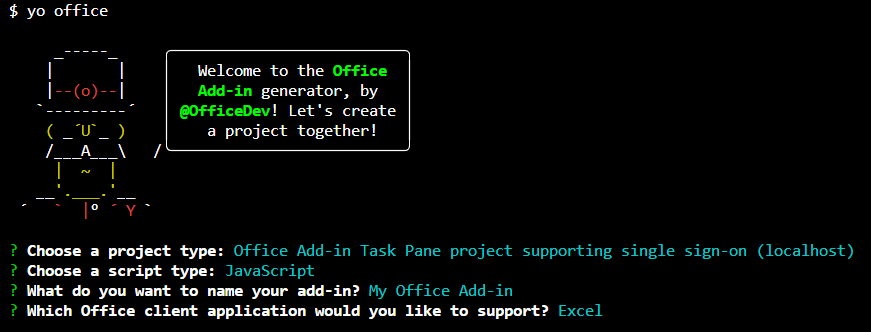
After you complete the wizard, the generator creates the project and installs supporting Node components.
Explore the project
The add-in project that you've created with the Yeoman generator contains code for an SSO-enabled task pane add-in.
Configuration
The following files specify configuration settings for the add-in.
The ./manifest.xml or manifest.json file in the root directory of the project defines the settings and capabilities of the add-in.
The ./.ENV file in the root directory of the project defines constants that are used by the add-in project.
Task pane
The following files define the add-in's task pane UI and functionality.
The ./src/taskpane/taskpane.html file contains the HTML markup for the task pane.
The ./src/taskpane/taskpane.css file contains the CSS that's applied to content in the task pane.
The ./src/taskpane/taskpane.js file contains code to initialize the add-in and also code that uses the Office JavaScript API library to add the data from Microsoft Graph to the Office document.
Authentication
The following files facilitate the SSO process and write data to the Office document.
In a JavaScript project, the ./src/helpers/documentHelper.js file contains code that encapsulates the user's profile information for insertion into the current Office document. There's no such file in a TypeScript project. Instead, the code that gathers the profile information is inline in the ./src/taskpane/taskpane.ts file.
The ./src/helpers/fallbackauthdialog.html file is the UI-less page that loads the JavaScript for the fallback authentication strategy. The
<script>tag to load the JavaScript is inserted into the file when Webpack.config.js runs.The ./src/helpers/fallbackauthdialog.js file contains the JavaScript for the fallback authentication strategy that signs in the user with msal.js.
The ./src/helpers/message-helper.js file contains JavaScript that shows or hides error messages to the user.
The ./src/helpers/middle-tier-calls.js file contains the JavaScript that calls your web API for fetching data.
The ./src/helpers/sso-helper.js file contains the JavaScript call to the SSO API,
getAccessToken, receives the access token, and includes it in a call to Microsoft Graph for the data. In the event of an error or in scenarios when SSO authentication isn't supported, it invokes the fallback strategy.
Configure SSO
Now that your add-in project is created and contains the code that's necessary to facilitate the SSO process, complete the following steps to configure SSO for your add-in.
Go to the root folder of the project.
cd "My Office Add-in"Run the following command to configure SSO for the add-in.
npm run configure-ssoWarning
This command will fail if your tenant is configured to require two-factor authentication. In this scenario, you'll need to manually complete the Azure app registration and SSO configuration steps by following all the steps in the Create a Node.js Office Add-in that uses single sign-on tutorial.
A web browser window will open and prompt you to sign in to Azure. Sign in to Azure using your Microsoft 365 administrator credentials. These credentials will be used to register a new application in Azure and configure the settings required by SSO.
Note
If you sign in to Azure using non-administrator credentials during this step, the
configure-ssoscript won't be able to provide administrator consent for the add-in to users within your organization. SSO will therefore not be available to users of the add-in and they'll be prompted to sign-in.After you enter your credentials, close the browser window and return to the command prompt. As the SSO configuration process continues, you'll see status messages being written to the console. As described in the console messages, files within the add-in project that the Yeoman generator created are automatically updated with data that's required by the SSO process.
Test your add-in
If you've created an Excel, Word, or PowerPoint add-in, complete the steps in the following section to try it. If you've created an Outlook add-in, complete the steps in the Outlook section instead.
Excel, Word, and PowerPoint
Complete the following steps to test an Excel, Word, or PowerPoint add-in.
When the SSO configuration process completes, run the following command to build the project, start the local web server, and sideload your add-in in the previously selected Office client application.
Note
Office Add-ins should use HTTPS, not HTTP, even while you're developing. If you're prompted to install a certificate after you run one of the following commands, accept the prompt to install the certificate that the Yeoman generator provides. You may also have to run your command prompt or terminal as an administrator for the changes to be made.
If this is your first time developing an Office Add-in on your machine, you may be prompted in the command line to grant Microsoft Edge WebView a loopback exemption ("Allow localhost loopback for Microsoft Edge WebView?"). When prompted, enter
Yto allow the exemption. Note that you'll need administrator privileges to allow the exemption. Once allowed, you shouldn't be prompted for an exemption when you sideload Office Add-ins in the future (unless you remove the exemption from your machine). To learn more, see "We can't open this add-in from localhost" when loading an Office Add-in or using Fiddler.
When you first use Yeoman generator to develop an Office Add-in, your default browser opens a window where you'll be prompted to sign in to your Microsoft 365 account. If a sign-in window doesn't appear and you encounter a sideloading or login timeout error, run
atk auth login m365.
npm startWhen Excel, Word, or PowerPoint opens when you run the previous command, make sure you're signed in with a user account that's a member of the same Microsoft 365 organization as the Microsoft 365 administrator account that you used to connect to Azure while configuring SSO in step 3 of the previous section. Doing so establishes the appropriate conditions for SSO to succeed.
In the Office client application, choose the Home tab, and then choose Show Task Pane to open the add-in task pane.

At the bottom of the task pane, choose the Get My User Profile Information button to initiate the SSO process.
If a dialog window appears to request permissions on behalf of the add-in, this means that SSO is not supported for your scenario and the add-in has instead fallen back to an alternate method of user authentication. This may occur when the tenant administrator hasn't granted consent for the add-in to access Microsoft Graph, or when the user isn't signed in to Office with a valid Microsoft account or Microsoft 365 Education or Work account. Choose Accept to continue.
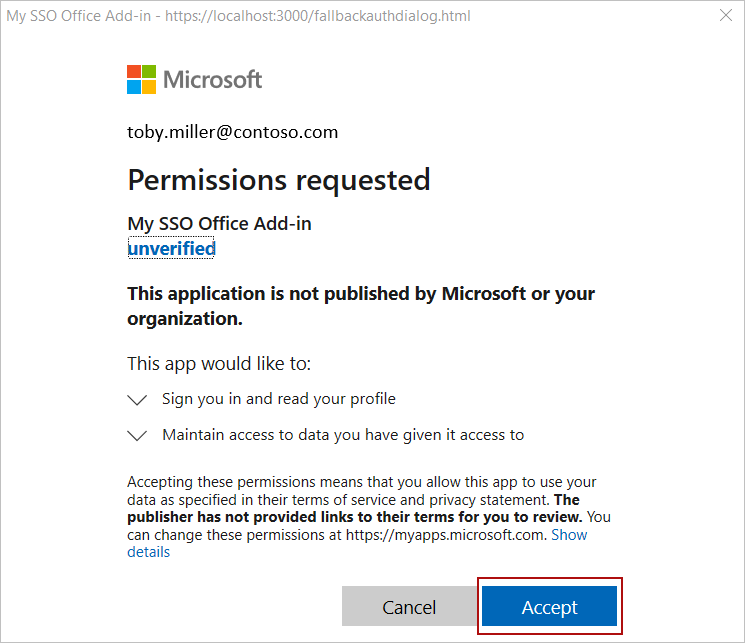
Note
After a user accepts this permissions request, they won't be prompted again in the future.
The add-in retrieves profile information for the signed-in user and writes it to the document. The following image shows an example of profile information written to an Excel worksheet.
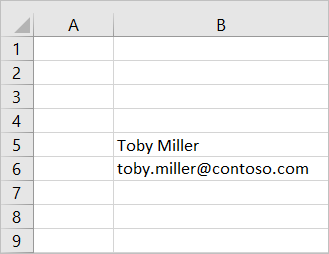
When you want to stop the local web server and uninstall the add-in, follow the applicable instructions:
To stop the server, run the following command. If you used
npm start, the following command also uninstalls the add-in.npm stopIf you manually sideloaded the add-in, see Remove a sideloaded add-in.
Outlook
Complete the following steps to try out an Outlook add-in.
When the SSO configuration process completes, run the following command to build the project and start the local web server.
Note
Office Add-ins should use HTTPS, not HTTP, even while you're developing. If you're prompted to install a certificate after you run one of the following commands, accept the prompt to install the certificate that the Yeoman generator provides. You may also have to run your command prompt or terminal as an administrator for the changes to be made.
If this is your first time developing an Office Add-in on your machine, you may be prompted in the command line to grant Microsoft Edge WebView a loopback exemption ("Allow localhost loopback for Microsoft Edge WebView?"). When prompted, enter
Yto allow the exemption. Note that you'll need administrator privileges to allow the exemption. Once allowed, you shouldn't be prompted for an exemption when you sideload Office Add-ins in the future (unless you remove the exemption from your machine). To learn more, see "We can't open this add-in from localhost" when loading an Office Add-in or using Fiddler.
When you first use Yeoman generator to develop an Office Add-in, your default browser opens a window where you'll be prompted to sign in to your Microsoft 365 account. If a sign-in window doesn't appear and you encounter a sideloading or login timeout error, run
atk auth login m365.
npm startOutlook will start and sideload the add-in. Make sure that you're signed in to Outlook with a user that's a member of the same Microsoft 365 organization as the Microsoft 365 administrator account that you used to connect to Azure while configuring SSO in step 3 of the previous section. Doing so establishes the appropriate conditions for SSO to succeed.
In Outlook, compose a new message.
In the message compose window, choose the Show Taskpane button to open the add-in task pane.
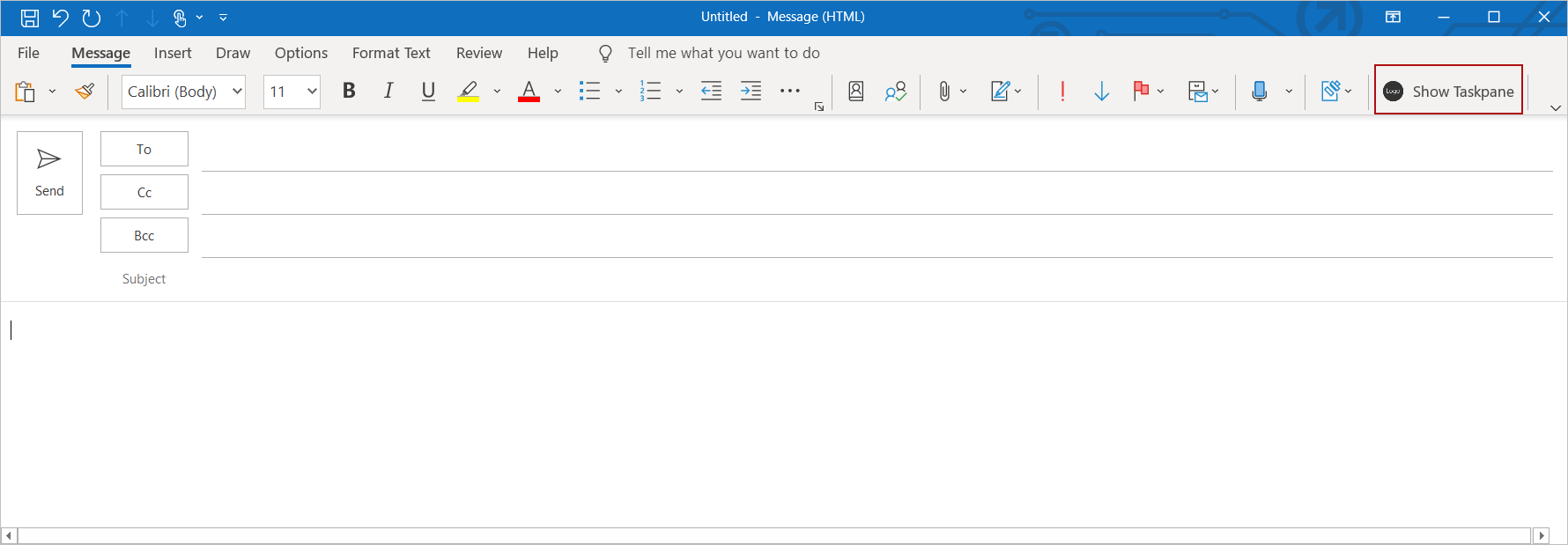
At the bottom of the task pane, choose the Get My User Profile Information button to initiate the SSO process.
If a dialog window appears to request permissions on behalf of the add-in, this means that SSO is not supported for your scenario and the add-in has instead fallen back to an alternate method of user authentication. This may occur when the tenant administrator hasn't granted consent for the add-in to access Microsoft Graph, or when the user isn't signed in to Office with a valid Microsoft account or Microsoft 365 Education or Work account. Choose Accept to continue.

Note
After a user accepts this permissions request, they won't be prompted again in the future.
The add-in retrieves profile information for the signed-in user and writes it to the body of the email message.
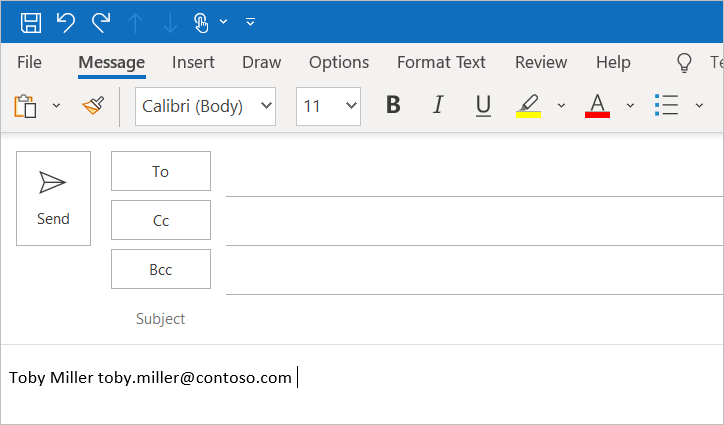
When you want to stop the local web server and uninstall the add-in, follow the applicable instructions:
To stop the server, run the following command. If you used
npm start, the following command should also uninstall the add-in.npm stopIf you manually sideloaded the add-in, see Remove a sideloaded add-in.
Next steps
Congratulations, you've successfully created a task pane add-in that uses SSO when possible, and uses an alternate method of user authentication when SSO is not supported. To learn about customizing your add-in to add new functionality that requires different permissions, see Customize your Node.js SSO-enabled add-in.
Troubleshooting
- Ensure your environment is ready for Office development by following the instructions in Set up your development environment.
The automatic
npm installstep Yo Office performs may fail. If you see errors when trying to runnpm start, navigate to the newly created project folder in a command prompt and manually runnpm install. For more information about Yo Office, see Create Office Add-in projects using the Yeoman Generator.You may see warnings generated when running
npm installfor either Yeoman generator or the project. In most cases, you can safely ignore these warnings. Sometimes, dependencies become deprecated and their replacements aren't supported by other packages on which the project depends. If you would like to resolve these warnings, use thenpm-check-updatestool.- In the command prompt while in the root project directory, run
npm i -g npm-check-updates. This installs the tool globally. - Run
ncu -u. This provides a report of all packages and to what versions they will be updated. - Run
npm installto update all the packages.
For more information about warnings when running
npm install, see Warnings and dependencies in the Node.js and npm world.- In the command prompt while in the root project directory, run
See also
Office Add-ins